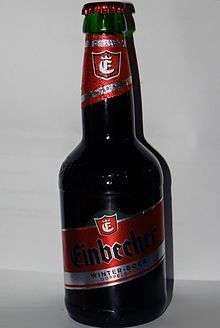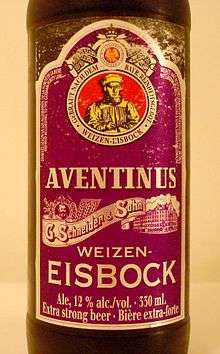Bock
Bock is a strong lager of German origin. Several substyles exist, including maibock (helles bock, heller bock), a paler, more hopped version generally made for consumption at spring festivals; doppelbock (double bock), a stronger and maltier version; and eisbock, a much stronger version made by partially freezing the beer and removing the ice that forms.
 Einbecker Winterbock in traditional "Einbecker" bottle | |
| Type | Lager |
|---|---|
| Country of origin | Germany |
| Introduced | 14th century |
| Colour | Light copper to brown |
| Variants | Maibock, doppelbock, eisbock |
Originally a dark beer, a modern bock can range from light copper to brown in colour.[1] The style is very popular, with many examples brewed internationally.
History
The style known now as bock was a dark, malty, lightly hopped ale first brewed in the 14th century by German brewers in the Hanseatic town of Einbeck.[2] The style from Einbeck was later adopted by Munich brewers in the 17th century and adapted to the new lager style of brewing. Due to their Bavarian accent, citizens of Munich pronounced "Einbeck" as "ein Bock" ("a billy goat"), and thus the beer became known as "bock". As a visual pun, a goat often appears on bock labels.[2]
Bock is historically associated with special occasions, often religious festivals such as Christmas, Easter or Lent (the latter as Lentenbock). Bocks have a long history of being brewed and consumed by Bavarian monks as a source of nutrition during times of fasting.[3]
Styles of bock
Traditional bock
Traditional bock is a sweet, relatively strong (6.3%–7.2% by volume), lightly hopped (20–27 IBUs) lager. The beer should be clear, and colour can range from light copper to brown, with a bountiful and persistent off-white head. The aroma should be malty and toasty, possibly with hints of alcohol, but no detectable hops or fruitiness. The mouthfeel is smooth, with low to moderate carbonation and no astringency. The taste is rich and toasty, sometimes with a bit of caramel. Again, hop presence is low to undetectable, providing just enough bitterness so that the sweetness is not cloying and the aftertaste is muted.[1] The following commercial products are indicative of the style: Point Bock (Stevens Point Brewery) Einbecker Ur-Bock Dunkel, Pennsylvania Brewing St. Nick Bock, Aass Bock, Great Lakes Rockefeller Bock, Stegmaier Brewhouse Bock.
Maibock
The maibock style, also known as helles bock or heller bock, is a helles lager brewed to bock strength; therefore, still as strong as traditional bock, but lighter in colour and with more hop presence. It is a fairly recent development compared to other styles of bock beers, frequently associated with springtime and the month of May. Colour can range from deep gold to light amber with a large, creamy, persistent white head, and moderate to moderately high carbonation, while alcohol content ranges from 6.3% to 7.4% by volume. The flavour is typically less malty than a traditional bock, and may be drier, hoppier, and more bitter, but still with a relatively low hop flavour, with a mild spicy or peppery quality from the hops, increased carbonation and alcohol content. The following commercial products are indicative of the style: Ayinger Maibock, Mahr's Bock, Hacker-Pschorr Hubertus Bock, Capital Maibock, Einbecker Mai-Urbock, Hofbräu Maibock, Victory St. Boisterous, Gordon Biersch Blonde Bock, Smuttynose Maibock, Old Dominion Brewing Company Big Thaw Bock, [Brewery 85's Quittin' Time], Rogue Dead Guy Ale, Franconia Brewing Company Maibock Ale, Church Street maibock, and Tröegs Cultivator.
Doppelbock
Doppelbock or double bock is a stronger version of traditional bock that was first brewed in Munich by the Paulaner Friars, a Franciscan order founded by St. Francis of Paula.[3] Historically, doppelbock was high in alcohol and sweet, thus serving as "liquid bread" for the Friars during times of fasting, when solid food was not permitted. Today, doppelbock is still strong—ranging from 7%–12% or more by volume. It isn't clear, with colour ranging from dark gold, for the paler version, to dark brown with ruby highlights for darker version. It has a large, creamy, persistent head (although head retention may be impaired by alcohol in the stronger versions). The aroma is intensely malty, with some toasty notes, and possibly some alcohol presence as well; darker versions may have a chocolate-like or fruity aroma. The flavour is very rich and malty, with toasty notes and noticeable alcoholic strength, and little or no detectable hops (16–26 IBUs). Paler versions may have a drier finish. The monks who originally brewed doppelbock named their beer "Salvator" (literally "Savior", but actually a malapropism for "Sankt Vater", "St. Father", originally brewed for the feast of St. Francis of Paola on 2 April which often falls into Lent), which today is trademarked by Paulaner.[3] Brewers of modern doppelbocks often add "-ator" to their beer's name as a signpost of the style; there are 200 "-ator" doppelbock names registered with the German patent office.[3] The following are representative examples of the style: Paulaner Salvator, Ayinger Celebrator, Weihenstephaner Korbinian, Andechser Doppelbock Dunkel, Spaten Optimator, Augustiner Maximator, Tucher Bajuvator, Weltenburger Kloster Asam-Bock, Capital Autumnal Fire, EKU 28, Eggenberg Urbock 23º, Bell's Consecrator, Moretti La Rossa, Samuel Adams Double Bock, Tröegs Tröegenator Double Bock, Wasatch Brewery Devastator, Great Lakes Doppelrock, Abita Andygator, Wolverine State Brewing Company Predator, Burly Brewing's Burlynator, and Christian Moerlein Emancipator Doppelbock.
Eisbock

Eisbock is a traditional specialty beer of the Kulmbach district of Germany that is made by partially freezing a doppelbock and removing the water ice to concentrate the flavour and alcohol content, which ranges from 9% to 13% by volume. It is clear, with a colour ranging from deep copper to dark brown in colour, often with ruby highlights. Although it can pour with a thin off-white head, head retention is frequently impaired by the higher alcohol content. The aroma is intense, with no hop presence, but frequently can contain fruity notes, especially of prunes, raisins, and plums. Mouthfeel is full and smooth, with significant alcohol, although this should not be hot or sharp. The flavour is rich and sweet, often with toasty notes, and sometimes hints of chocolate, always balanced by a significant alcohol presence. The following are representative examples of the style: Colorado Team Brew "Warning Sign", Kulmbacher Reichelbräu Eisbock, Eggenberg, Schneider Aventinus Eisbock, Urbock Dunkel Eisbock, Franconia Brewing Company Ice Bock 17%.
The strongest ice-beer, Schorschbräu, is produced by a Franconian company; it has 57% ABV (alcohol by volume), which claims to be a world record for beer ABV.[4]
Weizenbock
Weizenbock is a style of bock brewed using 40–60% wheat instead of all barley. It was first produced in Bavaria in 1907 by G. Schneider & Sohn and was named Aventinus after a Bavarian historian. The style combines darker Munich malts and top-fermenting wheat beer yeast, brewed at the strength of a doppelbock.[5]
References
- Bockbier - starker Genuss mit langer Tradition. Deutscher Brauer-Bund. 2011.
- "Michael Jackson's Beer Hunter – Original Bock: the beer the doctor ordered". www.beerhunter.com. Retrieved 7 October 2010.
- "Doppelbock". German Beer Institute. 2006. Archived from the original on 22 October 2010. Retrieved 7 October 2010.
- "Schorschbräu 57% 0,33". Schorschbraeu (in German). Retrieved 23 June 2019.
- Klemp, K. Florian (1 March 2014). "Understanding the Weizenbock Style". All About Beer. Retrieved 11 October 2016.
External links
| Wikimedia Commons has media related to Bock. |
| Wikisource has the text of the 1920 Encyclopedia Americana article Bock Beer. |